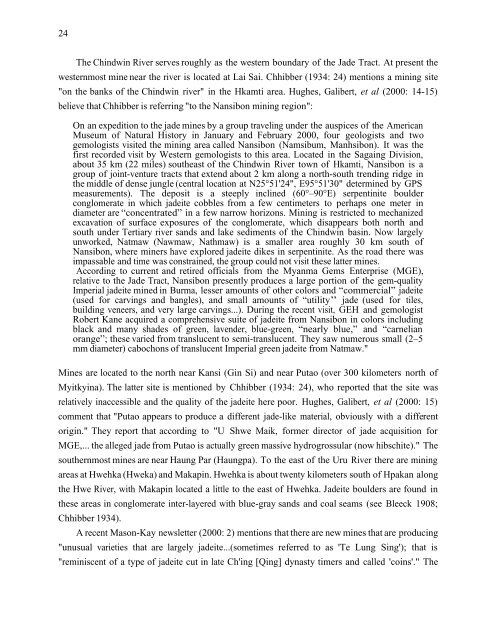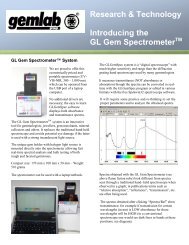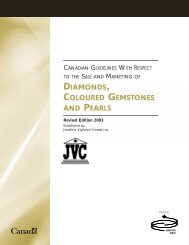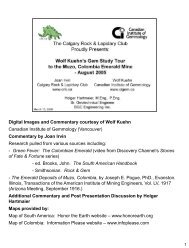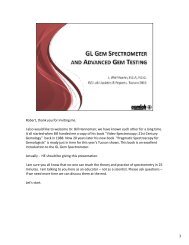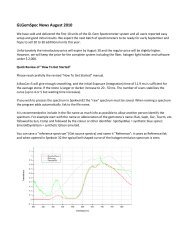JADEITE - Canadian Institute of Gemmology
JADEITE - Canadian Institute of Gemmology
JADEITE - Canadian Institute of Gemmology
Create successful ePaper yourself
Turn your PDF publications into a flip-book with our unique Google optimized e-Paper software.
24<br />
The Chindwin River serves roughly as the western boundary <strong>of</strong> the Jade Tract. At present the<br />
westernmost mine near the river is located at Lai Sai. Chhibber (1934: 24) mentions a mining site<br />
"on the banks <strong>of</strong> the Chindwin river" in the Hkamti area. Hughes, Galibert, et al (2000: 14-15)<br />
believe that Chhibber is referring "to the Nansibon mining region":<br />
On an expedition to the jade mines by a group traveling under the auspices <strong>of</strong> the American<br />
Museum <strong>of</strong> Natural History in January and February 2000, four geologists and two<br />
gemologists visited the mining area called Nansibon (Namsibum, Manhsibon). It was the<br />
first recorded visit by Western gemologists to this area. Located in the Sagaing Division,<br />
about 35 km (22 miles) southeast <strong>of</strong> the Chindwin River town <strong>of</strong> Hkamti, Nansibon is a<br />
group <strong>of</strong> joint-venture tracts that extend about 2 km along a north-south trending ridge in<br />
the middle <strong>of</strong> dense jungle (central location at N25°51'24", E95°51'30" determined by GPS<br />
measurements). The deposit is a steeply inclined (60°–90°E) serpentinite boulder<br />
conglomerate in which jadeite cobbles from a few centimeters to perhaps one meter in<br />
diameter are “concentrated” in a few narrow horizons. Mining is restricted to mechanized<br />
excavation <strong>of</strong> surface exposures <strong>of</strong> the conglomerate, which disappears both north and<br />
south under Tertiary river sands and lake sediments <strong>of</strong> the Chindwin basin. Now largely<br />
unworked, Natmaw (Nawmaw, Nathmaw) is a smaller area roughly 30 km south <strong>of</strong><br />
Nansibon, where miners have explored jadeite dikes in serpentinite. As the road there was<br />
impassable and time was constrained, the group could not visit these latter mines.<br />
According to current and retired <strong>of</strong>ficials from the Myanma Gems Enterprise (MGE),<br />
relative to the Jade Tract, Nansibon presently produces a large portion <strong>of</strong> the gem-quality<br />
Imperial jadeite mined in Burma, lesser amounts <strong>of</strong> other colors and “commercial” jadeite<br />
(used for carvings and bangles), and small amounts <strong>of</strong> “utility” jade (used for tiles,<br />
building veneers, and very large carvings...). During the recent visit, GEH and gemologist<br />
Robert Kane acquired a comprehensive suite <strong>of</strong> jadeite from Nansibon in colors including<br />
black and many shades <strong>of</strong> green, lavender, blue-green, “nearly blue,” and “carnelian<br />
orange”; these varied from translucent to semi-translucent. They saw numerous small (2–5<br />
mm diameter) cabochons <strong>of</strong> translucent Imperial green jadeite from Natmaw."<br />
Mines are located to the north near Kansi (Gin Si) and near Putao (over 300 kilometers north <strong>of</strong><br />
Myitkyina). The latter site is mentioned by Chhibber (1934: 24), who reported that the site was<br />
relatively inaccessible and the quality <strong>of</strong> the jadeite here poor. Hughes, Galibert, et al (2000: 15)<br />
comment that "Putao appears to produce a different jade-like material, obviously with a different<br />
origin." They report that according to "U Shwe Maik, former director <strong>of</strong> jade acquisition for<br />
MGE,... the alleged jade from Putao is actually green massive hydrogrossular (now hibschite)." The<br />
southernmost mines are near Haung Par (Haungpa). To the east <strong>of</strong> the Uru River there are mining<br />
areas at Hwehka (Hweka) and Makapin. Hwehka is about twenty kilometers south <strong>of</strong> Hpakan along<br />
the Hwe River, with Makapin located a little to the east <strong>of</strong> Hwehka. Jadeite boulders are found in<br />
these areas in conglomerate inter-layered with blue-gray sands and coal seams (see Bleeck 1908;<br />
Chhibber 1934).<br />
A recent Mason-Kay newsletter (2000: 2) mentions that there are new mines that are producing<br />
"unusual varieties that are largely jadeite...(sometimes referred to as 'Te Lung Sing'); that is<br />
"reminiscent <strong>of</strong> a type <strong>of</strong> jadeite cut in late Ch'ing [Qing] dynasty timers and called 'coins'." The


